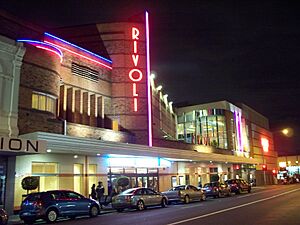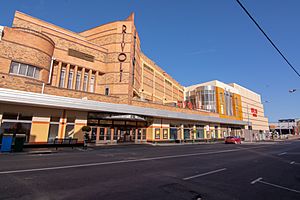Rivoli Cinemas facts for kids
The Rivoli Cinemas is a famous movie theater in Hawthorn East, a suburb of Melbourne, Australia. It's also known as the Rivoli Theatre or New Rivoli Theatre. This cinema is special because it has eight screens, making it a multiplex (a cinema with many screens). It's also famous for its cool Art Deco style of building design. The Rivoli first opened its doors in 1940. It was later updated and expanded in 2000 to become the modern cinema you see today.
Contents
Discovering Rivoli Cinemas' Past
The Rivoli Cinemas is located at 200 Camberwell Road. It first opened on October 11, 1940. The very first movie shown was French Without Tears, starring Ray Milland. Back then, the cinema was huge, with space for 1,644 people. There were 1,004 seats in the main area and 640 seats in the balcony.
How the Rivoli Cinema Started
The 1940 Rivoli replaced an older theater with the same name. That first Rivoli was built in 1921 on Burke Road. Robert McGleish, a well-known person in Melbourne's cinema world, managed the first Rivoli. He was also in charge of building the new, bigger Rivoli. The new cinema was designed by architects H. Vivian Taylor & Soilleux.
Rivoli's Big Changes Over Time
In 1968, the Rivoli made history. It became the first cinema in Australia to be split into two separate movie rooms. This meant people could choose between two different movies at the same time. The main balcony area became one cinema, keeping its fancy decorations. A smaller cinema was made in the lower seating area.
This change helped the cinema stay popular. Many cinemas struggled from the 1950s to the 1990s. But then, going to the movies became popular again. In 1999, a big renovation started. It cost about $16 million. Six new screens were added to the building's west side.
In 2005, the Rivoli was added to the Victorian Heritage Register. This means it's a very important historical building.
Rivoli's Amazing Architecture
The Rivoli Cinemas is a fantastic example of Streamline Moderne architecture. This style is also called Art Moderne. It was a popular design from the late 1930s and is a type of Art Deco. The Rivoli is the only complete building left by H. Vivian Taylor and Soilleaux. These architects were experts in cinemas. They designed or helped with over 500 cinemas and theaters in Australia. The Rivoli is known for its impressive brickwork outside and beautiful plasterwork inside.
Outside the Rivoli Cinema
The outside of the cinema has special horizontal brick patterns. These bricks are in shades of pink and oatmeal. There's also a tall, vertical fin (a flat, upright part of the building). On the east side, you can see a curved balcony wall. The west side has a roof garden. The walls around the doors used to have cream and orange tiles. These were lost over time but were put back during the 1999–2000 renovation. The Art Deco-style signs on the fin were also restored.
Inside the Rivoli Cinema
When the cinema first opened, its inside was very luxurious. There was a round ticket hall on the ground floor. A dramatic circular staircase led up to a lounge area. This lounge also gave access to the roof garden. The main movie room had two levels. Its plaster walls and ceiling were built in a new way, separate from the building's main structure. Decorative grilles were added for looks and to help with sound. Most of the lighting was hidden behind the plasterwork.
During the 1999–2000 renovation, many new areas were added. However, the original plasterwork in the upper movie room was kept. The main entrance areas, the circular staircase, and the upper lounge also look much like they did originally.
Because the cinema is so important, its restoration was carefully planned. Experts from Heritage Victoria and the Art Deco & Modernism Society (ADMS) helped. They made sure the original design and quality were kept.
Cinema Ghosts
In 2003, the Rivoli Cinemas was mentioned in an ABC science story. This story looked into whether ghosts are real. According to staff at the cinema, several spirits live in the building. One is said to be a man in Row P of Cinema One!



